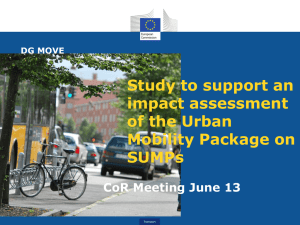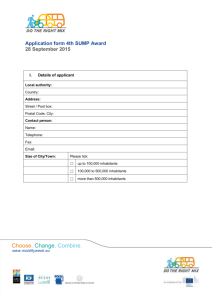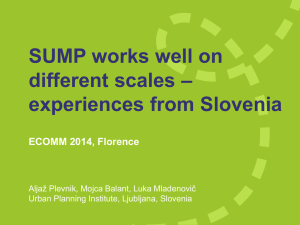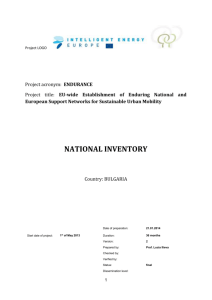Project LOGO Your organisation logo
advertisement
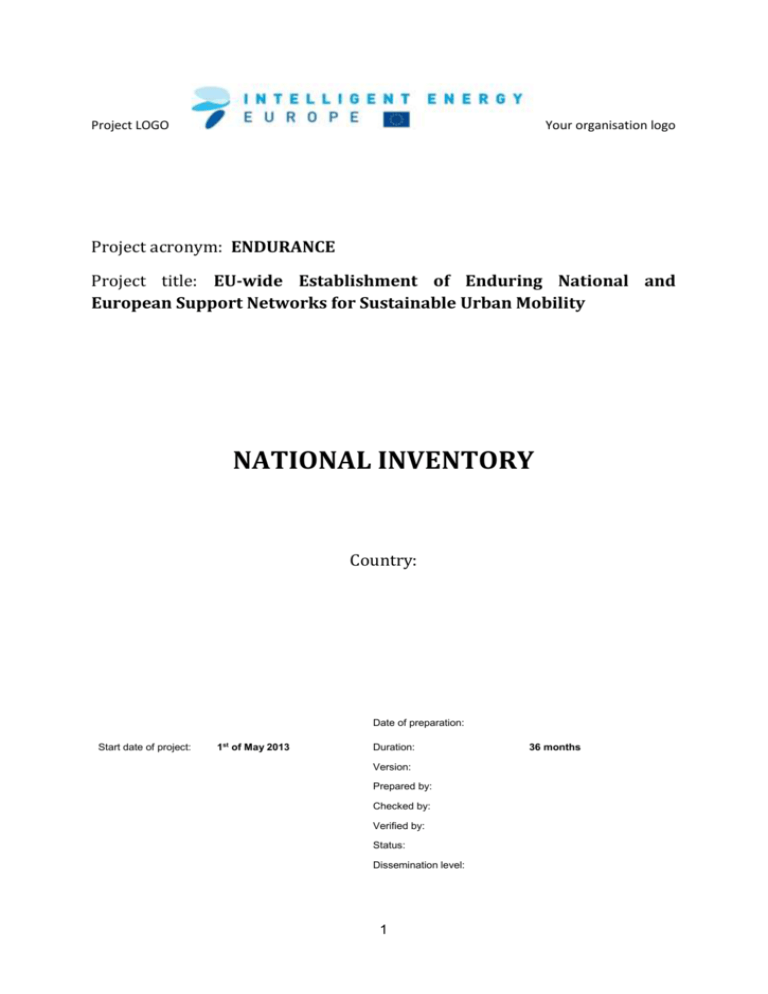
Project LOGO Your organisation logo Project acronym: ENDURANCE Project title: EU-wide Establishment of Enduring National and European Support Networks for Sustainable Urban Mobility NATIONAL INVENTORY Country: Date of preparation: Start date of project: 1st of May 2013 Duration: Version: Prepared by: Checked by: Verified by: Status: Dissemination level: 1 36 months TABLE OF CONTENT Introduction................................................................................................................. 3 National inventories as a basis for roadmaps ............................................... 4 Standardised structure of the national inventory ....................................... 5 A) Awareness of SUMPs in your country.............................................................................................................6 B) Planning tools used in your country................................................................................................................6 C) State of the art of SUMPs implementation in your country ...................................................................8 D) Most active partners in your country .......................................................................................................... 10 E) Existing initiatives in your country ............................................................................................................... 10 F) Potential financial resources for SUMPs preparation and the SUMP network funding .......... 13 2 Introduction This document comprises the first step within the WP2 tasks of the ENDURANCE project focused on building-up of enduring national networks on SUMPs. A ‘National SUMP Network’ is a national network which actively supports its members in preparing and implementing Sustainable Urban Mobility Plans (SUMPs). The national SUMPS networks will then: · · · · · foster a national policy and national support for SUMP organise and develop information, training and training materials in the local language facilitate national knowledge exchange between cities be the national contact point and thus to channel and to institutionalise the knowledge exchange on the international level be able to provide support to cities and agglomerations in terms of sustainable mobility. The networks aim at encouraging and supporting cities to engage in sustainable urban mobility planning and implementation. This requires country-specific approaches as the starting point and situation differs among countries and even among cities within a country. Each country partner in ENDURANCE is called a National Focal Point (NFP): it is the focal point for the national networks and the contact point for international exchange and communication for its country. Each NFP will prepare a national inventory of already existing network structures as well as of relevant stakeholders and initiatives in terms of sustainable mobility planning. 3 National inventories as a basis for roadmaps The national inventories will serve as a basis for producing roadmaps of national SUMP network formation. The roadmaps will be updated in the course of the ENDURANCE project and they will also give the path on which the networks will develop and continue after the project ends. The roadmaps will serve as a guideline for the central task of the ENDURANCE WP2: the actual national network development. Thus the national inventories are the first step to feed the inputs which are necessary for network foundation / adaption and should cover above all the following: - what has already been done, - what has worked well (why) - and what hasn't (and why) - the actual status of these networks, - the demand for SUMP services, - already available local resources and further important contacts that could support the networking and SUMP implementation on national, regional and local level. The inventory of the national level network status can build on the already existing national networks on Mobility Management that have been built up within the project EPOMM-PLUS. These existing national networks (in 21 countries) need to be thematically expanded to cover SUMP. In four countries that were neither in EPOMM-PLUS nor in EPOMM (Denmark, Slovakia, Latvia and Ireland) there is no such national network structure, neither for MM nor for SUMP. Here the network needs to be built up from scratch. The inventories will cover the actual status of these networks, and the potential for the SUMP networks to be established. WP2 is closely connected with WP3. WP3 will make an inventory of all cities and actors in your country which were involved in EU projects related to SUMP. These partners can make an important contribution to the roadmaps and the SUMP networks we are going to build and endure. 4 Standardised structure of the national inventory To fill in the template, please use, among others, the following sources: SUMP State of the art: http://mobilityplans.eu/docs/file/eltisplus_state-of-theart_of_sumps_in_europe_sep2011_final.pdf EPOMM MM-monitors: http://epomm.eu/index.php?id=2616 ELTISplus, above all awareness raising and training events (the Workshop Follow-Up Report is available for: Belgium, Bulgaria, Estonia, Finland, Germany, Greece, Hungary, Ireland, Italy, Latvia, Lithuania, Poland, Slovenia) We would like to kindly ask you to go through the following template and fill in the national inventory accordingly, to summarise all the needed inputs to be able to build on them roadmaps and further activities. Feel free to adjust the template to specifics in your country, when needed. Please send your national inventory by email to: radomira.jordova@cdv.cz and zbynek.sperat@cdv.cz by June 24, 2013. Thank you. 5 A) Awareness of SUMPs in your country A.1. SUMP acceptance and awareness by cities in your country Are cities in your country familiar with the concept of SUMP? To which extent? In Italy the majority of the cities are familiar with the concept of SUMP, as in Italy the legislation uses the term PUM (Urban Mobility Plan): PUM aren’t mandatory, but the article 22 of the Law n. 340 of 2000 establishes that single Municipalities or aggregation of Municipalities with more 100.000 inhabitants can receive a state funding up to 60% of the whole investment of the Mobility Urban Plan (PUM). The Italian PUM can be considered as a SUMP, as the Italian legislation (article 22 of the Law n. 340 of 2000) says that “a PUM is an integrated project on urban mobility including infrastructural measures on public and private transport ... as well as on demand management by means the network of the mobility managers ...”. A.2. Gaps in awareness and how to overcome them Do you see any gaps in awareness of SUMPs? (E.g. cities have heard about SUMPs, but do not always understand how it could contribute to better planning / cities do not know what topics are included and what tools are usually incorporated in SUMPs / cities do not know any practical example from other cities how it works, etc.). How can these awareness gaps be overcome in your country and generally how to raise awareness of SUMPs in your country? In some cities there is little awareness of SUMPs, that is some cities don’t know exactly what topics have to be included and what tools have to be incorporated in a SUMP. Through workshops and seminaries it is possible to overcome any gaps. In these meeting it should be important to invite both experts of sector and testimonial coming from cities to be considered as good practices. A.4. Specific up-to-date needs of cities related to SUMP topic Have some of the cities’ needs been identified yet in your country (e.g. in ELTISplus)? If so, please fill in what are these cities’ needs. If not, you will be able to fill in this question after contacting the cities in WP3. The identified needs might be from these areas: Awareness / communication: Legislation: Funding: Political representation: Missing experts / expert knowledge: Missing experience / inspiration from other cities: Other: Any comments / explanations / details: No needs yet identified, so we will be able to fill in this question after contacting the cities in WP3. B) Planning tools used in your country B.1. Legislation (laws and regulations) related to sustainable mobility in your country 6 Are there any major policies supporting introduction and/or implementation of SUMPs in your country? National level: National transport policy x□ National cycling policy x□ Legislation on air quality x□ Legislation on PT quality / energy efficiency x□ Land use prescribing obligations in transport planning x □ Others: Legislation on Mobility Management, that is the Italian Decree on urban sustainable mobility emanated by the Italian ministry of Environment that introduced in 1998 the mobility managers in Italy. Comments, details (how does the national legislation contribute to the SUMPs implementation in your country?): In Italy there are many policies that could promote a sustainable mobility, but they are not combined in a single law and this creates difficulties in their application. Each of them has useful elements to the SUMPs implementation. In Italy 20 Regions are present. As an example the Veneto region is presented Regional level: (Please fill in per region) [Region name]: Veneto Regional transport policy X□ Regional cycling policy □ Legislation on air quality X□ Legislation on PT quality / energy efficiency □ Land use prescribing obligations in transport planning X □ Others: Regional Guidelines for PUM (http://www.regione.veneto.it/static/www/mobilita-e-trasporti/Capitolo15.pdf) realisation Comments, details (how does the regional legislation contribute to the SUMPs implementation in your country?): B.2. Approach of national public institutions towards the concept of SUMPs What is the approach of public institutions and cities towards the concept of SUMP like (i.e. towards creation of a consolidated, comprehensive transport policy covering all key topics and tools towards sustainable mobility): Regarding Legislation: Article 22 of the Law n. 340 of 2000 Funding: Regulation on specific fund for PUMs authorized by Transport Ministry and Economic Planning Ministry 7 Providing of guidelines for creation of SUMPs: The Ministry of Infrastructure and Transport emanated guidelines and some Regions adopted own guidelines to address PUM’s Municipalities. Other: Comments, details: According to the guidelines emanated by The Ministry of Infrastructure and Transport the actions that fall in the Italian PUM are aimed to: • meeting the mobility needs of the population; • bringing down the levels of air and noise pollution in accordance with the agreements International and Community and national rules for the culling of pollutant emissions; • reducing energy consumption; • increasing the level of safety of the transport and road traffic; • minimizing the use of private individual and moderate traffic; • increasing the capacity of transport; • Increasing the percentage of people transported by collective systems, with solutions car pooling, car sharing, taxis, etc..; • reducing congestion in urban areas characterized by a high density of traffic through the identification of integrated transport system and infrastructure capable of fostering better regional planning and urban systems; • encouraging the use of alternative means of transport with the lowest possible environmental impact. C) State of the art of SUMPs implementation in your country C.1. What has been done in your country regarding SUMPs implementation? Please explain what the experience from the SUMPs implementation in your country is like: [Tip: consult the Eltis case studies from your country (search on topic transport planning and land use)] Good experience - why: National bodies: Regional bodies: Networks / associations of cities: NGOs: Cities: Parma [Description of the measure] Good experience because: [Description of the measure] Good experience because: [Description of the measure] Good experience because: [Description of the measure] Good experience because: The city of Parma integrated an Urban Transport Plan with a Land-use plan. The process made use of scenario building to help with establishing the effects that the measures would have and assessing the consequences of current trends, measures already programmed, and new policy choices. Parma is a medium-sized city (about 200,000 inhabitants) located in northern Italy. In 2005, the Municipality of Parma started an integrated urban transport and land-use planning process, made up of an Urban Mobility Plan (PUM) (similar to a SUMP), an Urban Traffic Plan (PGTU) and a land-use plan (PSC). Drafting the two transport plans (the PUM and the PGTU) together encouraged connections between the short term actions promoted by the PGTU and the demand management policies and the infrastructural projects that are part of the strategic scenario outlined by the PUM. Moreover the drafting of the two plans in context allows for a consistent and articulate strategy of mobility management that is able to coordinate the demand on different transport modes and the different services provided both to private and public mobility 8 (with particular attention to walking, cycling and disabled people) [Description of the measure] Good experience because: Scenarios help stakeholders better understand the likely combined effects that the measures discussed in a SUMP will have. By illustrating different future situations, it allows them to assess independently the consequences of current trends, measures already programmed, and new policy choices. Examining the effects of these different scenarios enables you to set realistic targets for outcome indicators. [Description of the measure] Good experience because: Other institutions: Bad experience - why: National bodies: Regional bodies: Networks / associations of cities: NGOs: Cities: Other institutions: [Description of the measure] Bad experience because: [Description of the measure] Bad experience because: [Description of the measure] Bad experience because: [Description of the measure] Bad experience because: [Description of the measure] Bad experience because: [Description of the measure] Bad experience because: C.2. What cities have implemented a SUMP in your country? Please provide lists of cities (and resp. contact details of cities) which have already implemented a SUMP, cities planning to introduce a SUMP, and cities interested in the topic (needing more attention and information to be provided). Fill in the table according to your best knowledge to make a “starting” overview – WP3 will soon provide you with city files from your country, including the cities’ participation in SUMP projects and contact details. Cities with implemented SUMP 1 2 3 3 4 5 6 7 8 9 10 11 12 13 Cities planning to introduce SUMP Novara (1, 3) Parma (1, 3) Milano (1, 3) Brescia (1, 3) Bergamo (1, 3) Genova (1, 3) Trento (3) Venezia (1, 3) Verona (1, 3) Padova (1, 3) Firenze (1, 3) Prato (1) Livorno Modena (1, 3) Cities interested in SUMP Rome (2, 3) Pisa (2) Monza (2) Treviso (2) San Benedetto del Tronto (2) Ancona (3) Aosta (3) Catania (3) Forlì (3) Napoli (3) Palermo (3) Piacenza (3) Reggio Calabria (3) Salerno (3) 9 Ravenna (1, 3) Reggio Emilia (1, 3) Rimini (3) Perugia (1, 3) Pescara L’Aquila Bari (1, 3) Foggia (3) Potenza (3) Messina(3) Cagliari (1) Catanzaro Torino (1) Bolzano (1) 15 16 17 18 19 20 21 22 23 24 25 26 27 28 Siracusa (3) Terni (3) Trieste (3) Udine (3) Vicenza (3) Any comments / explanations / details: In Italy are present: Cities that adopted a PUM as legal document; Cities that implemented elements of sustainable mobility non included in an integrated document. The Cities included in the Column “Cities planning to introduce SUMP” are the cities that adopted a PUM according to the annual survey carried out by Euromobility on the main 50 Italian cities (the adoption of a PUM doesn’t mean that the PUM has been implemented, that is that the measures of the adopted PUM as legal document of the Municipality have been implemented). The Cities included in the Column “Cities interested in SUMP” are the cities that implemented elements of sustainable mobility according to the observatory of the QUEST project, or the cities where a Mobility Management Office at City level is operative. (1) cities that adopted a PUM according to the annual survey carried out by Euromobility on the main 50 Italian cities and where mobility management measures are operative (2) cities that implemented elements of sustainable mobility according to the observatory of the QUEST project (3) Cities where a Mobility Management Office at City level is operative D) Most active partners in your country Identify stakeholders and partners active in sustainable mobility, mobility management and sustainable urban mobility plans (SUMPs) in your country and provide a list of them. Focus on national/regional/local actors – WP3 will soon provide you with information on EU project activity in your country. Name of the institution Euromobility Main area of activities Mobility Management Activities related to SUMPs up to now (relevant projects, etc.) Several projects of mobility management, dissemination Environment Ministry Protection of Environment, Land and Sea Member of EPOMM 10 Contact details (web page, contact person, email, phone etc.) www.euromobility.org Lorenzo Bertuccio l.bertuccio@euromobility.org +39(0)689021723 www.minambiente.it Giovanna Rossi Rossi.Giovanna@minambiente.it Muoversi Mobility Management No activities ISIS Transport and Mobility, Energy and Environment, Planning and Participation Training and Research on Transport QUEST Project Environmental organisation which is involved in campaigns and initiatives in favour of the bike use. It promotes interventions to protect municipalities interests. Citiy club to encourage the bike sharing service No activities National agency for new technologies, and sustainable economic development Increasing green economy sector in Italy No activities ASSTRA National Transports Association No activities Legambiente National association for environment protection Coordinating association of the local car sharing initiatives No activities ISFORT FIAB ANCI CCBS ENEA Fondazione Sviluppo Sostenibile ICS +39(0)657225359 www.muoversi.net Federico Isenburg +39(0)283420350 info@muoversi.net www.isis-it.com Maurizio Tomassini mtomassini@isis-it.com +39(0)632126 55 MUSA Project (Sustainable Urban Mobility and Cultural Attractions) www.isfort.it Gerardo Marletto marletto@uniss.it +39(0)6852651 www.fiab-onlus.it Giulietta Pagliaccio giulietta.pagliaccio@gmail.com No activities www.anci.it Vincenzo Santoro +39(0)6680091 santoro@anci.it No activities http://www.euromobility.org/CCBS/CCB S_new.htm Emanuela cafarelli +39(0)689021723 ccbs@euromobility.org www.enea.it Gabriella Messina gabriella.messina@enea.it +39(0)30484154 No activities www.susdef.it Raimondo Orsini +39(0)68414815 orsini@susdef.it www.asstra.it Daniela Carbone carbone@asstra.it +39(0)68603516 www.legambiente.it Alberto Fiorillo +39(0)686218474 alberto.fiorillo@gmail.com No activities www. icscarsharing.it Marco Mastretta +39(0)105577826 info@icscarsharing.it 11 E) Existing initiatives in your country What are the existing national networks operating in the field of transport / sustainable transport, energy efficiency, health, regional development and other areas relevant for SUMP implementation in your country? (e.g. EPOMM-Plus network, CIVINET, Healthy cities association, etc.) Name of the network Scope of activities (national/regional/local) Number of participating cities /other institutions Ministry of Environmen t EPOMMPlus EPOMM-Plus member building up national networks on MM Euromo bility Promoting Mobility Management in Italy POLIS Polis is a network of European cities and regions working together to develop innovative technologies and policies for local transport CCBS Increasing usage of bike sharing 16 cities ICS Coordinating association of the local car sharing initiatives 11 cities ANCI It promotes interventions to protect municipalities interests. 8341 Municipaliti s 24 members, including Municipaliti es, Regions and companies 6 Italian cities, 1 Region, 1 mobility agency. Relevance to SUMPs Coordinated by (contact data) Encouraging Municipalities in including mobility management measures within SUMPs Encouraging Municipalities in including mobility management measures within SUMPs As Polis includes Cities and Regions for Better Transport, the aim of Polis matches with the aim of a SUMP Bike sharing is one of the intervention in which PUM is part of it. Car sharing is one of the intervention in which PUM is part of it. Giovanna Rossi Rossi.Giovanna@minambiente.it +39(0)657225359 Lorenzo Bertuccio l.bertuccio@euromobility.org +39(0)689021723 +32(2)500 56 70 polis@polisnetwork.eu Euromobility +39(0)689021723 ccbs@euromobility.org Marco Mastretta +39(0)105577826 info@icscarsharing.it Municipality of Pavia +39(0)6680091 santoro@anci.it 12 F) Potential financial resources for SUMPs preparation and the SUMP network funding Please indicate shortly what resources might be available for cities to create a SUMP in your country (a more detailed list will be developed later in roadmaps): - at the local level : Municipalities funds according with the deliberation - at the regional level: Regional funds according with the deliberation - at the national level: National funds according with financial law - at the EU level: Intelligence Energy Europe - other financial resources: 13
